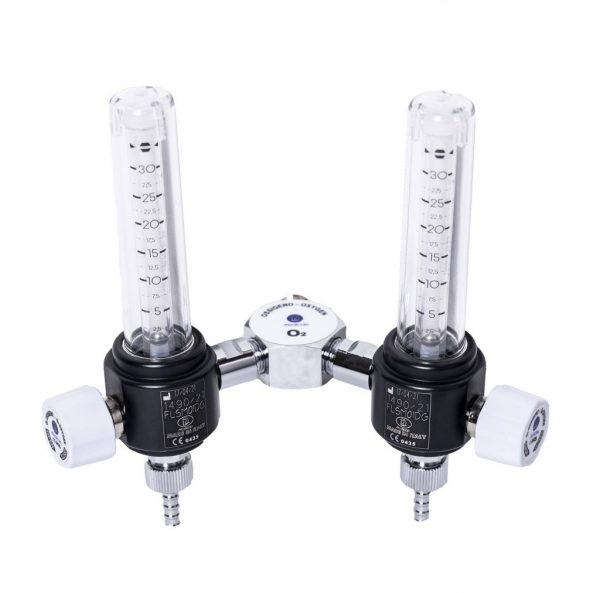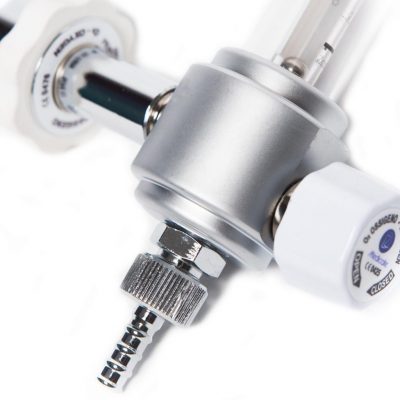Accuracy of Medical Flowmeters: A multicenter field study
The accuracy of 476 oxygen flowmeters was analyzed using a thermal mass flowmeter in eight hospitals in France and Belgium. Different oxygen flow rates (2 to 15 l/min) at the patient’s bedside were evaluated. Considering the sample as a whole, the accuracy of the flow delivered was acceptable, but the accuracy was poor. Variability in delivered flow between devices was greatest when low flow was required. Pressure-compensated oxygen flowmeters for these low flow rates have been found to be more accurate than their uncompensated counterparts. This study emphasizes the need to individually adjust the oxygen flow rate each time the patient needs to switch from one flowmeter to another.
In Europe, the accuracy of flow measurement devices to be connected to medical gas wall distribution systems is regulated by ISO 15002 standards. According to this standard, the oxygen flow rate should not deviate from the nominal value by more than 0.5 l/min when the flow rate is less than 5 l/min, and by more than 10% above this threshold. The conditions under which the flow rate is to be evaluated are well standardized: temperature of 23°C (± 2°C) and atmospheric pressure of 1013 hPa.

Oxygen is commonly administered in the care of both chronic and acute patients. In 2008, 18% of hospitalized patients in Britain received oxygen on a daily basis [1] . The appropriate oxygen flow rate varies widely from one situation to another. Patients with severely impaired blood-gas exchange may require a high inspiratory oxygen concentration. In these situations, a nonrebreather mask (or reservoir mask) is typically used, requiring an oxygen flow of up to 12-15 l/min [2] . For other patients, an oxygen flow of 2 to 10 l/min, via nasal puncture or simple mask, is generally sufficient to ensure adequate oxygenation [2] . However, oxygen therapy can be deleterious. Its concomitant use with bleomycin [3] or paraquat (1,1 dimethyl 4,4′ bipyridyl) can cause irreversible pulmonary fibrosis leading to death [4] . High inspiratory oxygen fractions are associated with retrolental fibroplasia in premature infants [5] or oxygen denitrogenation atelectasis [6] . Recently, some authors have also shown that hyperoxia could induce potentially harmful cerebral and myocardial vasoconstriction in ischemic diseases [7] .A reasonable goal for oxygen therapy is therefore to achieve hemoglobin saturation (SpO2) between 94 and 98% [2] .
It is estimated that 2000-4000 deaths could be prevented each year in Britain if the oxygen flow rate were more appropriate [1] . Therefore, the accuracy of the oxygen flow delivery system is important.
The Firm
This field study was conducted in 8 hospitals (number of beds > 250). Oxygen flowmeters (TT) with Thorpe tube (range: 0 to 15 l/min) have been studied in adult units where oxygen is frequently administered (intensive care unit, emergency unit, respiratory unit, cardiology, surgery) [1] . The TT evaluated was the one routinely used in these services and assigned to the next patient requiring oxygen therapy.
First, the pressure in the local pipeline was checked. The TT was then plugged into the power outlet of an unoccupied room and placed vertically as a nurse would have done. Different gas flow rates (2 to 15 l/min) were evaluated in random order. The flow rate was set by aligning the center of the float ball with the suitable flow rate indicator line (nominal value) [10]. Each flow was measured twice and averaged for each TT. All settings and measurements were made by the same person.
Special care was taken to avoid parallax errors. Oxygen fluxes were measured with a calibrated thermal mass flow meter.
Oxygen flow was measured after stabilizing the reading for 5 seconds. Several types of TT were found during our evaluations. They were classified into two groups according to whether they were pressure compensated (PCTT: Timeter™, Caudalimeter™, RTM3™, RTM2™, Taema™) or not (NPCTT: Non-Pressure Compensated Thorpe Tube).

Results
476 oxygen flowmeters were analyzed in 8 hospitals (3 in France, 5 in Belgium) for a total of 13,328 measurements and 12 different brands of TT were found (Table 1). In both France and Belgium, pressure-compensated TT accounted for the majority of rotameters (70% and 66%, respectively). On average, the delivered flow rate matched the nominal value (NV) with a median value ranging from 94% to 100% NV depending on the flow rate considered.
On average, 35% ± 7% of flowmeters were considered inaccurate. When PCTTs were compared with NPCTTs, no statistically significant difference in median or range values was observed. The percentage of devices outside the range is acceptable according to ISO 15002 and CGA standards. At low flow rates, PCTT performed better than NPCTT, while the reverse was true at high flow rates (p < 0.05).
Conclusions
When the flow meter leaves the factory, its accuracy under standard conditions is guaranteed by the manufacturer. With time and use, its accuracy may alter, and the accuracy of the flow delivered in a hospital setting may differ from the original value. This study is the first large multicenter study evaluating the accuracy of wall-mounted oxygen flowmeters under common conditions of use. The objective of the present study was not the evaluation of any negligence, and the method used to adjust the flow rate was strictly in accordance with the manufacturer’s instructions. Our analysis shows that, on average, the oxygen flows delivered are close to the desired oxygen flow (nominal value).
Therefore, it is important to have accurate and reliable devices, especially when blood gas analysis is not directly accessible.Finally, inappropriate flow can cause logistical problems. This supply problem can be critical during out-of-hospital transport or when oxygen therapy is used to increase mobility and walking time.
Accuracy of Medical Oxygen Flowmeters: A Multicentric Field Study
Frédéric Duprez1,2,3*, Maria Barile2, Thierry Bonus2, Grégory Cuvelier3, Sandra Ollieuz2, Shahram Mashayekhi2, Alexandre Legrand1*
1Department of Physiology and Pharmacology, University of Mons, Mons, Belgium
2Intensive Care Unit, Centre Hospitalier Epicura, Hornu, Belgium
3Laboratory of Motion, Haute Ecole Condorcet, Tournai, Belgium
Email: *frederic.duprez@condorcet.be, *alexandre.legrand@umons.ac.be
Copyright © 2014 by authors and Scientific Research Publishing Inc.
This work is licensed under the Creative Commons Attribution International License (CC BY).
http://creativecommons.org/licenses/by/4.0/
